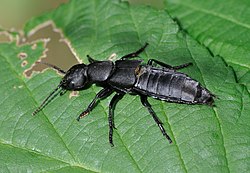Devil's coach horse beetle
| Devil's coach-horse beetle | |
|---|---|
 |
|
| Adult of Ocypus olens | |
| Scientific classification | |
| Kingdom: | Animalia |
| Phylum: | Arthropoda |
| Class: | Insecta |
| Order: | Coleoptera |
| Family: | Staphylinidae |
| Genus: | Ocypus |
| Species: | O. olens |
| Binomial name | |
|
Ocypus olens (O. F. Müller, 1764) |
|
| Synonyms | |
|
|
The Devil's coach-horse beetle (Ocypus olens) is a species of beetle belonging to the large family of the rove beetles (Staphylinidae). It was originally included in the genus Staphylinus in 1764, and some authors and biologists still use this classification.
The Latin species name olens, meaning smelling, refers to the two white stinking glands on the abdomen. This beetle has been associated with the Devil since the Middle Ages. Hence its common name, which has been used at least since 1840. Other names include Devil's footman, Devil's coachman and Devil's steed. It is sometimes also known as the cock-tail beetle for its habit of raising its abdomen. One dictionary proposed the name developed in parallelism with ladybird and its Norse cognates. In Irish, the beetle is called dearga-daol or darbh-daol. British folklore has it that a beetle has eaten the core of Eve's apple, and that a person who crushes such beetle is forgiven seven sins.
Subspecies within this species include:
These very common and widespread beetles are present in most of Europe and in North Africa. They also been introduced to the Americas and parts of Australasia. They prefer areas with damp conditions and they can be found from April to October in meadows, heath and moorland, woodlands, hedgerows, parks and gardens. During the day they commonly stay under logs, stones or leaf litter.
It is a long-bodied black beetle. At about 20–32 millimetres (0.8–1.3 in), it is one of the larger British beetles. Its wing covers (elytra) are short, covering only its thorax, exposing the abdominal segments. The abdominal musculature is powerful and the abdominal segments are covered with sclerotized plates. It is capable of flight, but its wings are rarely used. It is covered with fine, black hairs. It is well known for its habit of raising its long and uncovered abdomen and opening its jaws, rather like a scorpion when threatened. Although it has no sting, it can give a painful bite with its strong, pincer-like jaws. It also emits a foul-smelling odour, as a defensive secretion, from a pair of white glands at the end of its abdomen.
...
Wikipedia
